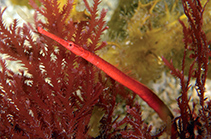| Family: |
Syngnathidae (Pipefishes and seahorses), subfamily: Syngnathinae |
| Max. size: |
14.55 cm SL (male/unsexed); 13.52 cm SL (female) |
| Environment: |
demersal; marine; depth range 11 - 12 m |
| Distribution: |
Southwest Paciic: Australia. |
| Diagnosis: |
This species differs from its congeners by the following set of characters: median ridge is distinct, low, present on dorsum of head and first trunk ring starting from the posterior third of the frontal, over the supraoccipital, to the anterior and posterior nuchal plates; opercular ridge is prominent, complete, not angled dorsad; lateromedial ridge is distinct, low, present between opercle and pectoral fin base; dorsal-fin origin on the 6th–7th trunk rings, subdorsal rings 19-20 (12 trunk rings + 7 or 8 tail rings); lateral trunk ridge ends on the first tail ring. Colouration: body with red background colour; dorsum of snout with large, irregular pale white spots; the sides of head and anterior trunk rings with large, irregular pale white spots or with diffuse pale white stripe; venter of first trunk ring with distinct red elongated spots in a longitudinal row, almost forming a stripe, on midline present in male (AMS I. 49510-001); venter of anterior trunk rings pale red with a large cluster of distinct red spots thst extends posteriad from second trunk ring in male (AMS I. 49510-001), a few scattered small red spots in females (AMS I.1.47267) (Ref. 123272). |
| Biology: |
This species inhabits semi-exposed bay entrances and ocean embayments in which the underwater terrain is characterised by sandy areas interspersed with boulders and hard flat reefs. Individuals and pairs of this species were observed in close association with a species of finger sponge appearing to a member of the family Callyspongiidae and several different species of red algae appearing to be of the family Gracilariaceae in the genera Crassiphycus and Gracilaria. It was not seen associating with any of the other numerous species of small to large sponges or tunicates present on the sessile-rich boulders nor within the canopy kelp Ecklonia radiata. It has also been observed on occasion active individuals swimming from one clump of red algae to another or feeding actively just outside the red algae. Feeding behaviour appears to be similar to other congeners, with individuals darting out from the cover of their alga to capture food such as small copepods and shrimp. (Ref. 123272). |
| IUCN Red List Status: |
Not Evaluated (N.E.) Ref. (130435)
|
| Threat to humans: |
harmless |
Source and more info: www.fishbase.org. For personal, classroom, and other internal use only. Not for publication.
